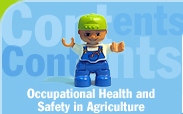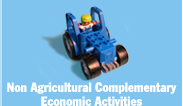|
Glossary
A|B|C|D|E|F|G|H|I|J|K|L|M|N|O|P|Q|R|S|T|U|V|W|X|Y|Z
Acquis Communautaire
the
body of European Community law, consisting of all the treaties
and legislation enacted by Community institutions and including
the CAP.
Act of Accession
A
part of the Treaty of Accession, which defines the conditions of
accession, or joining of the European Union, of new member
states.
Agenda
2000
-
a
policy of the European Commission adopted in March
1999,
to prepare for the planned expansion of the EU into central and
eastern Europe. It included
a six-year (2000-2006)
financial package designed to ease the enlargement of the
European EU. In the area of agriculture, the policy shifted the
CAP from price supports to direct payments and revised measures
that control the supply of products.
Aggregate Measurement of Support (AMS)
a calculation of the total government support provided to an
agricultural product, either product-specific or non-product
specific that was required under the Uruguay Round in order to
establish compliance with the agreed-upon reductions in domestic
support.
Agreement on Agriculture
part
of the Uruguay Round agreement on trade and tariffs, covering
agricultural issues, including market access, export subsidies
and internal support.
Agri-environmental Programme
a
regulation adopted by the EU as part of the CAP reforms of
1992,
which provided for payments to farmers for the costs and loss in
income resulting from the implementation of environmentally
beneficial activities on their land.
Bound Tariff Rates
tariff rates resulting from GATT negotiations that are
incorporated as part of a countrys schedule of concessions.
Bound rates are enforceable.
CAP
the Common Agricultural Policy, a set of regulations
procedures which basically regulate the production, trade and
processing of agricultural products within the European Union.
CEEC
Central and Eastern European countries, specifically the
10
countries that joined the EU on May
1,
2004
(Cyprus, Czech Republic, Estonia, Hungary, Latvia, Lithuania,
Malta, Poland, Slovakia, and Slovenia).
Ceiling
an
upper limit imposed by the EU to the amount of spending on the
CAP, fixed at the
1999
level until the year
2006.
Common Market
another term for the European Economic Community, which was
established by the Treaty of Rome
1957.
The term, common market emphasizes the free movement of
people, goods and capital within the member states, which was
the keystone of the Treaty of Rome.
Common Organisation of the Market (COM) -
a set of all the EU regulations relating to an individual
agricultural commodity, such as grains, oilseeds, protein crops,
tobacco, beef, sheep, and dairy products.
Cross-compliance
- a
feature of the
2003
reform to the CAP, which makes the payment of subsidies
conditional upon meeting certain standards outside of crop or
livestock production. These include the protection of the
environment, public and animal health, and animal welfare.
Farmers must also maintain their land in good agricultural and
environmental condition. Farmers who do not meet these standards
will have their subsidy reduced.
De-coupling
a major feature of the
2003
CAP reforms which separates the amount of subsidy paid to
farmers from the level of production. Farmers will receive
subsidies in the form of a single annual payment at a level that
is based on past income. The intent is to encourage them to farm
for the market, rather than for the subsidies.
Direct Payments
see
Single Payment Scheme,
below.
EAGGF
the
European Agricultural Guidance and Guarantee Fund, the part of
the Community budget that finances the CAP, first set
up in
1962.
It consists of two parts, the Guarantee Section and the Guidance
Section.
EEC
the
European Economic Community, which was created by the Treaty of
Rome in
1957
and was the predecessor to the European Union.
EU
the European Union, previously known as the European Economic
Community and the Common Market. Originally composed of
6
member states, it now has
25.
EU-15
the
European Union of
15
member states, before the expansion of May
1,
2004.
EU-25
the
European Union of
25
member states, after the expansion of May
1,
2004.
European Council (EC) -
the EU's main decision-making body, representing the member
states. Its meetings are attended by one minister from each of
the EU's national governments. The ministers attending a
particular meeting (e.g. foreign affairs, agriculture, etc.)
depend on what subjects are on the agenda. Nonetheless, the
Council is a single institution, and each minister in the
Council is empowered to commit his or her government.
European Commission
- the
European Commission is the executive body of the European Union
and is made up of
20
men and women appointed by the member states and Parliament to
run the institution and take its decisions. The Commission
proposes legislation, policies and programmes of action and it
is responsible for implementing the decisions of Parliament and
the Council.
Export Subsidy
a
subsidy paid to exporters, under the original CAP provisions,
whenever world market prices fell below official EU prices.
Farm Accountancy Data Network (FADN) -
the
Farm Accountancy Data Network (FADN) is an annual survey of
farms in the EU for purposes of evaluating the income of
agricultural holdings and the impacts of the Common Agricultural
Policy.
Financial Discipline
an
element of the
2003
reforms to the CAP requiring that CAP expenditures remain within
an established budgetary ceiling. This requirement extends until
2013.
GATT
the General Agreement on Trade and Tariffs, signed in Geneva in
1947,
was designed to provide an international forum that encouraged
free trade between member states by regulating and reducing
tariffs on traded goods and by providing a common mechanism for
resolving trade disputes
GDP
gross domestic product, a measure of the total output of goods
and services of a countrys economy.
Guarantee Section
the largest portion of the EAGGF, which finances Community
expenditures under the policy on prices and markets, including
CAP reform compensatory payments.
Guidance Section
- the portion of the EAGGF, which contains the Community
resources, allocated to the structures policy, including rural
development policy, aid for the modernization of holdings, the
installation of young farmers, and aid for processing and
marketing.
Integrated Administration and Control System (IACS)
the
EU-wide system that each member state must adopt for controlling
and processing farmers aid applications.
Intervention Price
under
the original CAP provisions, this was the floor price for a
commodity at which authorities would intervene and purchase
products in order to support the market.
Least Developed Countries (LDCs)
a
category of nations developed by the United Nations, which
currently
49
countries with the lowest national income, weak human assets and
high economic vulnerability. LDCs, which belong to the World
Trade Organisation, are exempt from subsidy and tariff reduction
targets for agriculture. Most of these nations are in Africa or
south Asia.
Less-Favoured Areas -
mountainous areas or other areas where the physical landscape
makes farming more expensive; the CAP provides additional
financial assistance to farmers in such areas.
Member States (MS) -
the
countries that belong to the European Union, which total
25
countries as of May
1,
2004.
Modulation
the
transfer of funds in the EU budget from agricultural subsidies
to rural development, as provided in the CAP reforms of
2003.
Paying Agency
the
agency responsible for administering subsidies under the CAP
Production Quotas
supply management measures under the CAP which have been applied
to milk and sugar in order to limit the amount of these
commodities which can be produced.
SAPARD
the
Special Accession Programme for Agriculture and Rural
Development, a programme of the European Union to assist in the
agricultural development of the central and eastern European
countries that joined the European Union in
2004.
Set-aside
the
practice of leaving a portion of farm land idle in return for
receiving compensatory payments. Set-asides are of two types:
compulsory and
voluntary.
Single Area Payment Scheme (SAPS)
an
optional method for payment of subsidies adopted as part of the
2003
CAP reforms that allows new member states to pay a single
subsidy to farmers that is based on the number of hectares
farmed.
Single Payment Scheme (SPS)
the
primary method for payment of subsidies to farmers adopted under
the
2003
CAP reforms. One payment will be made each year that is based on
the average of payments received under the prior subsidy schemes
during a historic reference period. This policy becomes
effective on January
1,
2005.
Supply Management Measure
one
of several CAP provisions intended to control or effects the
supply of an agricultural product. Such instruments may include
national production ceilings, maximum guaranteed areas, maximum
guaranteed quantities and production quotas.
Support Prices
prices for commodities fixed by the EU in order to determine,
directly or indirectly, domestic prices or producer prices.
Tarrification
the
conversion of any form of agricultural import restriction,
including quotas and other levies, into a tariff, as required by
the Uruguay Round Agreement on Agriculture.
Target Price
under the original CAP, this was the officially recognised
optimum price that a farmer should receive for a product, plus
transport costs to the market.
Treaty of Accession
- an international agreement concluded
between current and new Member States of the European Union
which defines the accession conditions of the new member states
and the consequent adaptations and adjustments of the treaties
on which the EU is founded.
TSEs
Transmissible Spongiform Encephalopathies, a family of diseases
of humans and animals characterized by spongy degeneration of
the brain with severe and fatal neurological signs and symptoms.
UAA
utilised agricultural area, or all
of the area of arable land, permanent meadow and pasture, and
land developed for permanent crops and kitchen gardens.
Uruguay Round Agreement (UR)
an agreement among the member states of the General Agreement on
Trade and Tariffs (GATT), made in
1994
and designed to open world markets. The EU and other countries
agreed to reductions and permanent limitations on subsidized
agricultural exports, both in volume and amount.
World Trade Organisation (WTO)
the WTO was created on January
1,
1995
under the Uruguay Round Agreement and replaced the General
Agreement on Trade and Tariffs (GATT) as the international body
managing trade relations among its members, which include the
European Union. |











